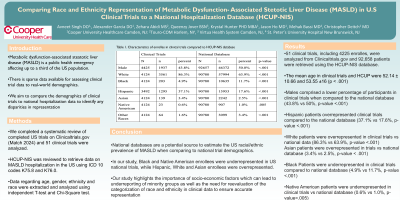Sunday Poster Session
Category: Liver
P1176 - Comparing Race and Ethnicity Representation of Metabolic Dysfunction-Associated Steatotic Liver Disease (MASLD) in U.S. Clinical Trials to National Hospitalization Database (HCUP-NIS)
Sunday, October 27, 2024
3:30 PM - 7:00 PM ET
Location: Exhibit Hall E

Has Audio

Avneet Singh, DO
Cooper University Hospital
Camden, NJ
Presenting Author(s)
Avneet Singh, DO1, Alexander Garcia, DO1, Zehara Abidi, BS, MS2, Queenzy Jover, BSN, RN3, Krystal Hunter, PhD, MBA4, Jason Ho, MD5, Mehak Bassi, MD6, Christopher Deitch, MD5
1Cooper University Hospital, Camden, NJ; 2Touro College of Osteopathic Medicine, New York, NY; 3Virtua Health System, Camden, NJ; 4Cooper University Health Care, Camden, NJ; 5Cooper Health Gastroenterology, Camden, NJ; 6St. Peter's University Hospital, New Brunswick, NJ
Introduction: Metabolic dysfunction-associated steatotic liver disease (MASLD) is a public health emergency affecting up to a third of the US population. When stratified by race and ethnicity, there is significant heterogeneity in prevalence and progression to severe disease amongst ethnic and racial groups. There is sparse data available for assessing clinical trial data to real-world demographics. Here, we compare the demographics of clinical trials to national hospitalization data to identify any disparities in representation.
Methods: We systematically reviewed completed clinical trials on Clinicaltrials.gov from inception until March 2024. The included studies were limited to MASLD in adults and studies with US clinical sites. US national data about MASLD hospitalizations were retrieved utilizing HCUP-NIS data from 2020 with ICD 10 codes K75.8 and K76.0. Two reviewers independently extracted and analyzed data, including age, gender, ethnicity, and race, using the Independent T-test and Chi-Square Test.
Results: The systematic review resulted in 51 clinical trials, which included 4225 enrollees, while HCUP-NIS retrieved 92,658 patients (p< .001). The mean age in clinical trials and HCUP were 52.14 ± 10.66 and 53.55 ±16 (p < .001). In clinical trials, males comprised a lower percentage of participants when compared to national data (43.8% vs 50%, p < .001). Hispanic patients were overrepresented when compared to national data (37.1% vs 17.6%, p < .001). Regarding racial composition, White and Asian participants were overrepresented in trials compared to national data (86.3% vs. 63.9%, p < .001) and (3.4% vs. 2.5%, p < .001). At the same time, Black and Native Americans were underrepresented (4.9% vs 11.7%, p < .001) and (0.6% vs 1.0%, p= .005).
Discussion: Equitable racial and ethnic representation is necessary for the external validity of clinical trials. National databases can serve as a source to estimate the US racial/ethnic prevalence of MASLD, but they are not enough. Our data reports an underrepresentation of Black and Native American enrollees in trials, while Hispanic, White and Asian enrollees were overrepresented. However, it's important to note that socio-economic factors can lead to underreporting of minority groups, highlighting the need for more comprehensive data collection. In addition, a reevaluation of how racial and ethnic identities are categorized in clinical data is necessary to ensure accurate representation.
Disclosures:
Avneet Singh, DO1, Alexander Garcia, DO1, Zehara Abidi, BS, MS2, Queenzy Jover, BSN, RN3, Krystal Hunter, PhD, MBA4, Jason Ho, MD5, Mehak Bassi, MD6, Christopher Deitch, MD5. P1176 - Comparing Race and Ethnicity Representation of Metabolic Dysfunction-Associated Steatotic Liver Disease (MASLD) in U.S. Clinical Trials to National Hospitalization Database (HCUP-NIS), ACG 2024 Annual Scientific Meeting Abstracts. Philadelphia, PA: American College of Gastroenterology.
1Cooper University Hospital, Camden, NJ; 2Touro College of Osteopathic Medicine, New York, NY; 3Virtua Health System, Camden, NJ; 4Cooper University Health Care, Camden, NJ; 5Cooper Health Gastroenterology, Camden, NJ; 6St. Peter's University Hospital, New Brunswick, NJ
Introduction: Metabolic dysfunction-associated steatotic liver disease (MASLD) is a public health emergency affecting up to a third of the US population. When stratified by race and ethnicity, there is significant heterogeneity in prevalence and progression to severe disease amongst ethnic and racial groups. There is sparse data available for assessing clinical trial data to real-world demographics. Here, we compare the demographics of clinical trials to national hospitalization data to identify any disparities in representation.
Methods: We systematically reviewed completed clinical trials on Clinicaltrials.gov from inception until March 2024. The included studies were limited to MASLD in adults and studies with US clinical sites. US national data about MASLD hospitalizations were retrieved utilizing HCUP-NIS data from 2020 with ICD 10 codes K75.8 and K76.0. Two reviewers independently extracted and analyzed data, including age, gender, ethnicity, and race, using the Independent T-test and Chi-Square Test.
Results: The systematic review resulted in 51 clinical trials, which included 4225 enrollees, while HCUP-NIS retrieved 92,658 patients (p< .001). The mean age in clinical trials and HCUP were 52.14 ± 10.66 and 53.55 ±16 (p < .001). In clinical trials, males comprised a lower percentage of participants when compared to national data (43.8% vs 50%, p < .001). Hispanic patients were overrepresented when compared to national data (37.1% vs 17.6%, p < .001). Regarding racial composition, White and Asian participants were overrepresented in trials compared to national data (86.3% vs. 63.9%, p < .001) and (3.4% vs. 2.5%, p < .001). At the same time, Black and Native Americans were underrepresented (4.9% vs 11.7%, p < .001) and (0.6% vs 1.0%, p= .005).
Discussion: Equitable racial and ethnic representation is necessary for the external validity of clinical trials. National databases can serve as a source to estimate the US racial/ethnic prevalence of MASLD, but they are not enough. Our data reports an underrepresentation of Black and Native American enrollees in trials, while Hispanic, White and Asian enrollees were overrepresented. However, it's important to note that socio-economic factors can lead to underreporting of minority groups, highlighting the need for more comprehensive data collection. In addition, a reevaluation of how racial and ethnic identities are categorized in clinical data is necessary to ensure accurate representation.
Disclosures:
Avneet Singh indicated no relevant financial relationships.
Alexander Garcia indicated no relevant financial relationships.
Zehara Abidi indicated no relevant financial relationships.
Queenzy Jover indicated no relevant financial relationships.
Krystal Hunter indicated no relevant financial relationships.
Jason Ho indicated no relevant financial relationships.
Mehak Bassi indicated no relevant financial relationships.
Christopher Deitch indicated no relevant financial relationships.
Avneet Singh, DO1, Alexander Garcia, DO1, Zehara Abidi, BS, MS2, Queenzy Jover, BSN, RN3, Krystal Hunter, PhD, MBA4, Jason Ho, MD5, Mehak Bassi, MD6, Christopher Deitch, MD5. P1176 - Comparing Race and Ethnicity Representation of Metabolic Dysfunction-Associated Steatotic Liver Disease (MASLD) in U.S. Clinical Trials to National Hospitalization Database (HCUP-NIS), ACG 2024 Annual Scientific Meeting Abstracts. Philadelphia, PA: American College of Gastroenterology.
